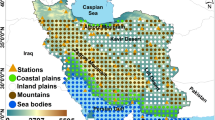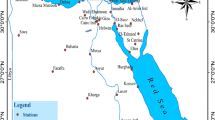Abstract
This study analyses the regional variations in rainfall over Darwin and its vicinity due to different large-scale circulations during the Australian summer by utilizing the combination of in situ and C-band polarimetric radar rainfall data at hourly resolution. The eight phases of the Madden–Julian oscillation as defined by Wheeler and Hendon (Mon Weather Rev 132(8):1917–1932, 2004) were used as indicators of different large-scale environments. The analysis found that the large-scale forcing starts to build up from phase 4 by the reversal of low- to mid-level easterly winds to moist westerly winds, reaching a maximum in phase 5 and weakening through phases 6–7. During phases 4–6, most of the study domain experiences widespread rainfall, but with distinct spatial and temporal structures. In addition, during these phases, coastal areas near Darwin receive more rainfall in the early morning (0200–0400 LT) due to the spreading or expansion of rainfall from the Beagle Gulf, explaining the occurrence of a secondary diurnal rainfall peak over Darwin. In contrast, local-scale mechanisms (sea breezes) reinvigorate from phase 8, further strengthening through phases 1–3, when low-level easterly winds become established over Darwin producing rainfall predominately over land and island locations during the afternoon. During these phases, below average rainfall is observed over most of the radar domain, except over the Tiwi Islands in phase 2.
















Similar content being viewed by others
References
Arritt RW (1993) Effects of the large-scale flow on characteristic features of the sea breeze. J Appl Meteorol 32(1):116–125
Beringer J, Tapper NJ, Keenan TD (2001) Evolution of maritime continent thunderstorms under varying meteorological conditions over the Tiwi Islands. Int J Climatol 21(8):1021–1036
Bringi V, Huang G-J, Chandrasekar V, Keenan T (2001) An areal rainfall estimator using differential propagation phase: evaluation using a C-band radar and a dense gauge network in the tropics. J Atmos Ocean Technol 18(11):1810–1818
Bringi V, Tang T, Chandrasekar V (2004) Evaluation of a new polarimetrically based Z-R relation. J Atmos Ocean Technol 21(4):612–623
Caine S, Jakob C, Siems S, May P (2009) Objective classification of precipitating convective regimes using a weather radar in Darwin, Australia. Mon Weather Rev 137(5):1585–1600
Carbone R, Wilson J, Keenan T, Hacker J (2000) Tropical island convection in the absence of significant topography. Part I: Life cycle of diurnally forced convection. Mon Weather Rev 128(10):3459–3480
Crook NA (2001) Understanding Hector: the dynamics of island thunderstorms. Mon Weather Rev 129(6):1550–1563
Crosman ET, Horel JD (2010) Sea and lake breezes: a review of numerical studies. Bound-Layer Meteorol 137(1):1–29
Drosdowsky W (1996) Variability of the Australian summer monsoon at Darwin: 1957–1992. J Clim 9(1):85–96
Drosdowsky W, Holland G (1987) North australian cloud lines. Mon Weather Rev 115(11):2645–2659
Grimsdell AW, Alexander MJ, May PT, Hoffmann L (2010) Model study of waves generated by convection with direct validation via satellite. J Atmos Sci 67(5):1617–1631
Hamilton K, Vincent RA, May PT (2004) Darwin Area Wave Experiment (DAWEX) field campaign to study gravity wave generation and propagation. J Geophys Res 109:1–15
Hendon HH, Liebmann B (1990a) A composite study of onset of the Australian summer monsoon. J Atmos Sci 47(18):2227–2240
Hendon HH, Liebmann B (1990b) The intraseasonal (30–50 day) oscillation of the Australian summer monsoon. J Atmos Sci 47(24):2909–2924
Holland GJ, McBride JL, Smith RK, Jasper D, Keenan TD (1986) The BMRC Australian monsoon experiment: AMEX. Bull Am Meteorol Soc 67(12):1466–1472
Hung CW, Yanai M (2004) Factors contributing to the onset of the Australian summer monsoon. Q J R Meteorol Soc 130(597):739–758
Kanamori H, Yasunari T, Kuraji K (2013) Modulation of the diurnal cycle of rainfall associated with the MJO observed by a dense hourly rain gauge network at Sarawak, Borneo. J Clim 26(13):4858–4875
Keenan TD, Carbone RE (1992) A preliminary morphology of precipitation systems in tropical northern Australia. Q J R Meteorol Soc 118(504):283–326
Keenan TD, Holland GJ, Manton MJ, Simpson J (1988) TRMM ground truth in a monsoon environment: Darwin, Australia. Aust Meteorl Magazine 36:81–90
Keenan TD, Manton MJ, Holland GJ, Morton BR (1989) The Island Thunderstorm Experiment (ITEX)—a study of tropical thunderstorms in the maritime continent. Bull Am Meteorol Soc 70(2):152–159
Keenan T, Morton B, Zhang XS, Nyguen K (1990) Some characteristics of thunderstorms over Bathurst and Melville Islands near Darwin, Australia. Q J R Meteorol Soc 116(495):1153–1172
Keenan T, Glasson K, Cummings F, Bird T, Keeler J, Lutz J (1998) The BMRC/NCAR C-band polarimetric (C-Pol) radar system. J Atmos Ocean Technol 15(4):871–886
Keenan T, May P, Holland G, Rutledge S, Carbone R, Wilson J, Moncrieff M, Crook A, Takahashi T, Tapper N (2000) The maritime continent thunderstorm experiment (MCTEX): overview and some results. Bull Am Meteorol Soc 81(10):2433–2455
Koike T (2004) The Coordinated Enhanced Observing Period—an initial step for integrated global water cycle observation. WMO Bull 53(2):115–121
Kumar VV, Protat A, May PT, Jakob C, Penide G, Kumar S, Davies L (2013) On the effects of large-scale environment and surface types on convective cloud characteristics over Darwin, Australia. Mon Weather Rev 141(4):1358–1374
Madden RA, Julian PR (1994) Observations of the 40–50-day tropical oscillation—a review. Mon Weather Rev 122(5):814–837
May PT, Ballinger A (2007) The statistical characteristics of convective cells in a monsoon regime (Darwin, Northern Australia). Mon Weather Rev 135(1):82–92
May PT, Mather JH, Vaughan G, Bower KN, Jakob C, McFarquhar GM, Mace GG (2008) The tropical warm pool international cloud experiment. Bull Am Meteorol Soc 89(5):629–645
May PT, Long CN, Protat A (2012) The diurnal cycle of the boundary layer, convection, clouds, and surface radiation in a coastal monsoon environment (Darwin, Australia). J Clim 25(15):5309–5326
McBride JL, Frank WM (1999) Relationships between stability and monsoon convection. J Atmos Sci 56(1):24–36
Miller S, Keim B, Talbot R, Mao H (2003) Sea breeze: structure, forecasting, and impacts. Rev Geophys 41(3):1–31
North GR, Bell TL, Cahalan RF, Moeng FJ (1982) Sampling errors in the estimation of empirical orthogonal functions. Mon Weather Rev 110(7):699–706
Oliphant A, Sturman A, Tapper N (2001) The evolution and structure of a tropical island sea/land-breeze system, northern Australia. Meteorol Atmos Phys 78(1–2):45–59
Pope M, Jakob C, Reeder MJ (2009a) Regimes of the north Australian wet season. J Clim 22(24):6699–6715
Pope M, Jakob C, Reeder MJ (2009b) Objective classification of tropical mesoscale convective systems. J Clim 22(22):5797–5808
Porson A, Steyn DG, Schayes G (2007) Formulation of an index for sea breezes in opposing winds. J Appl Meteorol Climatol 46(8):1257–1263
Protat A, Delanoë J, May P, Haynes J, Jakob C, O’Connor E, Pope M, Wheeler M (2011) The variability of tropical ice cloud properties as a function of the large-scale context from ground-based radar-lidar observations over Darwin, Australia. Atmos Chem Phys 11:8363–8384
Protat A, Rauniyar S, Kumar VV, Strapp JW (2014) Optimizing the probability of flying in high ice water content conditions in the tropics using a regional-scale climatology of convective cell properties. J Appl Meteor Climatol 53(11):2438–2456
Ramage CS (1968) Role of a tropical maritime continent in the atmospheric circulation. Mon Weather Rev 96(6):365–370
Rauniyar SP (2006) Characteristics and mechanism analysis of precipitation’s diurnal cycle based on CEOP. Dissertation (M. Sc.), University of Tokyo, Japan
Rauniyar SP, Rasmy M, Tamagawa K, Yang K, Koike T (2007) Prediction skill assessment of NWP models in simulating the diurnal cycle of precipitation. Annu J Hydraulic Eng, JSCE 51:97–102. doi:10.2208/prohe.51.97
Reynolds RW, Smith TM, Liu C, Chelton DB, Casey KS, Schlax MG (2007) Daily high-resolution-blended analyses for sea surface temperature. J Clim 20(22):5473–5496
Santos e Silva CM, Gielow R, de Freitas SR (2009) Diurnal and semidiurnal rainfall cycles during the rain season in SW Amazonia, observed via rain gauges and estimated using S-band radar. Atmos Sci Lett 10(2):87–93
Skinner T, Tapper N (1994) Preliminary sea breeze studies over Bathurst and Melville Islands, Northern Australia, as part of the Island Thunderstorm Experiment (ITEX). Meteorol Atmos Phys 53(1–2):77–94
Soman VV, Valdés JB, North GR (1995) Satellite sampling and the diurnal cycle statistics of Darwin rainfall data. J Appl Meteorol 34(11):2481–2490
Troup A (1961) Variations in upper tropospheric flow associated with the onset of the Australian summer monsoon. Indian J Meteorol Geophys 12:217–230
Wapler K, Lane TP (2012) A case of offshore convective initiation by interacting land breezes near Darwin, Australia. Meteorl Atmos Phys 115:123–137
Wheeler MC, Hendon HH (2004) An all-season real-time multivariate MJO index: development of an index for monitoring and prediction. Mon Weather Rev 132(8):1917–1932
Wheeler M, McBride J (2011) Australasian monsoon. In: Lau WKM, Waliser D (eds) Intraseasonal variability in the atmosphere–ocean climate system, 2nd edn. Springer, New York, pp 147–198
Wheeler MC, Hendon HH, Cleland S, Meinke H, Donald A (2009) Impacts of the Madden–Julian oscillation on Australian rainfall and circulation. J Clim 22(6):1482–1498
Xie S, McCoy RB, Klein SA, Cederwall RT, Wiscombe WJ, Jensen MP, Johnson KL, Clothiaux EE, Gaustad KL, Long CN, Mather JH, McFarlane SA, Shi Y, Golaz J-C, Lin Y, Hall SD, McCord RA, Palanisamy G, Turner DD (2010) CLOUDS AND MORE: ARM climate modeling best estimate data. Bull Am Meteorol Soc 91(1):13–20
Yang S, Smith EA (2006) Mechanisms for diurnal variability of global tropical rainfall observed from TRMM. J Clim 19(20):5190–5226
Zhang C (2005) Madden–Julian oscillation. Rev Geophys 43:RG2003. doi:10.1029/2004RG000158
Acknowledgments
The authors wish to thank Dr. Matthew Wheeler, Dr. Peter May and Dr. Alain Protat for their valuable suggestions and comments. We would also like to thank Michael Whimpey for providing the CPOL radar data. In this study, ERA-Interim data were obtained from the European Centre for Medium-Range Weather Forecasts and atmospheric variables datasets were obtained from the ARM Climate Modeling Best Estimate (CMBE) atmospheric and radiation datasets and from the Australian Bureau of Meteorology.
Author information
Authors and Affiliations
Corresponding author
Rights and permissions
About this article
Cite this article
Rauniyar, S.P., Walsh, K.J.E. Spatial and temporal variations in rainfall over Darwin and its vicinity during different large-scale environments. Clim Dyn 46, 671–691 (2016). https://doi.org/10.1007/s00382-015-2606-1
Received:
Accepted:
Published:
Issue Date:
DOI: https://doi.org/10.1007/s00382-015-2606-1




